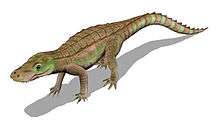Crocoduck
The crocoduck is a fictitious hybrid animal with the head of a crocodile and the body of a duck proposed by Ray Comfort and Kirk Cameron.
In creationism
The concept of a crocoduck was used by young-Earth creationists and certain other creationists to claim that the absence of any half-crocodile, half-duck creature disproves evolution, an argument that quickly became a meme used to ridicule a common misrepresentation of the theory of evolution, namely, that the theory predicts forms intermediate between any two currently living organisms.
In 2007 young-Earth creationists Kirk Cameron and Ray Comfort participated in a televised debate, parts of which were aired on ABC Nightline, on the existence of God. Kirk Cameron held up composite pictures of what "we imagined would be genuine species-to-species transitional forms. They called one a 'crocoduck' and another was called a 'birddog'." The "crocoduck" was an animal with the head of a crocodile and the body of a duck, the "bullfrog" was an animal with the head of a bull and the body of a frog, and the "sheepdog" was an animal with the head of a dog and the body of a sheep. These pictures were used as a straw man argument to ridicule the theory of evolution as represented by Cameron and Comfort.[1]
This claim was widely publicized and ridiculed as an example of creationist misconceptions. In The Greatest Show on Earth: The Evidence for Evolution, the evolutionary scientist Richard Dawkins included a section titled 'Show me your crocoduck!' in which he compared this to the question put by another creationist as to why there was no transitional fossil "fronkey" between frogs and monkeys, and described it as a warped misunderstanding of evolution. Modern species share a common ancestor, but are neither descended from each other nor from some crude composite chimera, and ducks are not descended from crocodiles. An illustration shows the Crocoduck Tie, designed by web designer Josh Timonen in commemoration of this misconception.[2] Dawkins has stated that "There are only two in existence. PZ Myers has one. I'm proud to say I have the other."[3] Dawkins' tie made a prominent appearance on an episode of The Colbert Report.[4]
Fossils

In 2003,[5] new fossils of several types of ancient crocodile were found, including one with a flat broad snout reminiscent of a duck's bill, though it has teeth and is obviously crocodilian rather than bird-like. This genus has been named Anatosuchus or "DuckCroc", and it had an upright stance rather than the sprawled legs of modern crocodiles.[6][7] Pelagornithid seabirds are also compared to aquatic crocodilians and are in fact recovered as stem-waterfowl, rendering them literal crocoducks.
The most recent common ancestor of duck and crocodiles is the base of the Archosauria clade, and was probably superficially similar to modern crocodiles. No fossil of this common ancestor are known to exist, but groups such as Phytosauria and Proterochampsia are near to the base of the archosaur clade. Although the phylogenetic distance from these groups to ducks and crocodiles are equal, in form and likely behaviour they are more similar to crocodiles.
In literature
The author and illustrator Chih-Yuan Chen from Taiwan produced the bestselling children's story Guji Guji in 2004,[8] a modern-day twist on The Ugly Duckling, in which a crocodile egg rolls into a duck's nest and is raised in a brood of ducklings,[9] growing up as a "crocoduck" who thinks he is "not a bad crocodile", but "not exactly a duck either."[10]
See also
- Creation–evolution controversy
- Intelligent design
- Kitzmiller v. Dover Area School District
- Reductio ad absurdum
- Feathered dinosaur
References
- Bashir, Martin (7 May 2007). "Does God Exist? The Nightline Face-Off". abcNews. Retrieved 25 October 2018.
- Dawkins, Richard (2009). The Greatest Show on Earth: The Evidence for Evolution. London: Bantam Press. pp. 152–154, fig. 8 facing p. 55. ISBN 978-0-593-06173-2. OCLC 390663505.
- Richard Dawkins (June 7, 2009). "Oooh, sniny : Pharyngula". Scienceblogs. Retrieved 2009-11-03.
#30 Yes, it is a great tie. The Crocoduck Tie, designed by Josh Timonen. There are only two in existence. PZ has one. I'm proud to say I have the other.
- "Richard Dawkins on The Colbert Report (2009.09.30)". Atheistmovies.blogspot.com. 2009-10-01. Archived from the original on 2012-11-15. Retrieved 2012-04-06.
- "A NEW NOTOSUCHIAN FROM THE EARLY CRETACEOUS OF NIGER" (PDF).
- "BoarCroc, RatCroc, DogCroc, DuckCroc and PancakeCroc". National Geographic. Archived from the original on 2010-01-10.
- "The Crocoduck!".
- Wray, James (30 November 2004). "Guji Guji: Crocoduck Grabs Spot on New York Times Bestseller List - Monsters and Critics". M & G Books.
- Pinkwater, Daniel; Simon, Scott (2 October 2004). "Crocodile Laughs in 'Guji Guji' : NPR". National Public Radio. Retrieved 3 November 2009.
- Bruder, Jessica (13 February 2005). "Children's Books". New York Times.